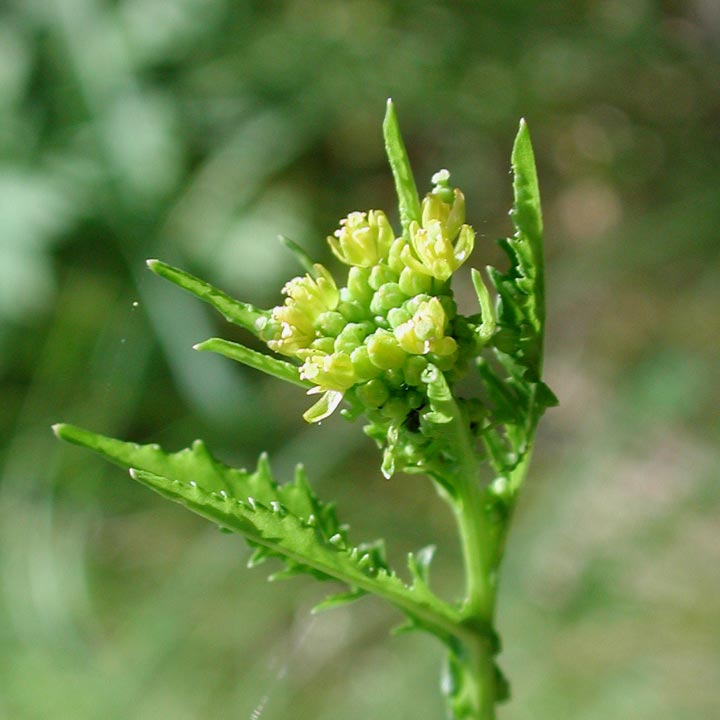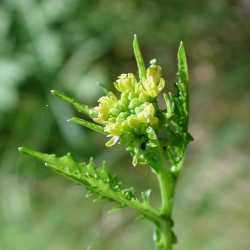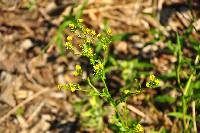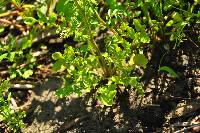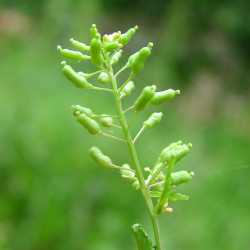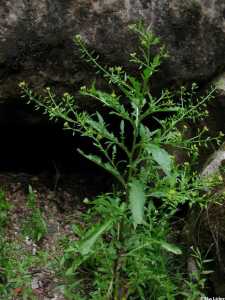Annuals or, rarely, perennials; (short-lived, terrestrial or of wet habitat, not submerged); usually glabrous, rarely hirsute, (trichomes cylindrical). Stems (often simple from base), erect, branched distally, (0.5-)1-10 (-14) dm, (sometimes hirsute proximally). Basal leaves rosulate; blade [(4-)6-20(-30) cm × 10-50(-80) mm] margins lyrate-pinnatisect, (abaxial surface sometimes hirsute). Cauline leaves petiolate or subsessile; blade lyrate-pinnatisect, (lateral lobes oblong or ovate when present), (1.5-)2.5-10(-18) cm × (5-)8-25(-30) mm, (lateral lobes smaller than terminal), base auriculate or amplexicaul, margins subentire or irregularly dentate, sinuate, serrate, or crenate, (abaxial surface sometimes hirsute). Racemes often considerably elongated. Fruiting pedicels divaricate or slightly to strongly reflexed, straight or curved, (2.5-)3-10(-14) mm. Flowers: sepals erect, oblong, 1.5-2.4(-2.6) × 0.5-1 mm; petals yellow or pale yellow, spatulate, (1.5-)1.8-2.5(-3) × 0.5-1.5(-2) mm; median filaments 1-2.5 mm; anthers ovate, 0.3-0.5 mm. Fruits usually silicles, rarely siliques, often slightly curved, oblong, ellipsoid, or oblong-ovoid, (2.5-)4-10 × (1.5-)1.7-3(-3.5) mm; ovules 20-90 per ovary; style 0.2-1(-1.2) mm. Seeds biseriate, brown to yellowish brown, ovoid or subglobose, 0.5-0.7(-0.9) mm (0.4- 0.6(-0.7) mm diam.), colliculate.
Annual or biennial herb with a taproot to 1 m tall
Stem: upright, branched.
Leaves: alternate, often pinnately divided (especially lower leaves), lance-shaped to oblong- reverse egg-shaped. The middle stem leaves are generally winged toward the lobed base, looking more or less stalkless.
Flowers: in branched clusters (racemes). Sepals four, ascending. Petals four, yellow, 1.5 - 2.5 mm long, about as long as sepals, bases narrowed. Stamens six.
Fruit: a pod (silique), 2.5 - 9 mm long, twice as long as stalks, more or less round in cross-section, may or may not be constricted in the middle.
Similar species: No information at this time.
Flowering: May to September
Habitat and ecology: Found in a variety of moist to wet areas.
Occurence in the Chicago region: native
Etymology: Rorippa possibly comes from the Latin roro, meaning "to be moist," and ripa, meaning riverbank. Palustris means "marsh-loving."
Author: The Morton Arboretum
Duration: Annual
Nativity: Native
Lifeform: Forb/Herb
General: Annual herbs, or rarely short-lived perennials, 5-140 cm tall; stems erect, often branched above the base.
Leaves: Alternate along the stems, on petioles with bases that clasp the stem; blades 1-8 cm long and 4-30 mm wide, lyrate-pinnatifid (pinnately lobed with the terminal lobe rounded and much larger than the lateral lobes), the margins smooth, toothed, or wavy.
Flowers: Tiny and yellow, clustered in dense terminal racemes that elongate considerably in fruit; pedicels ascending in flower and spreading in fruit, 3-14 mm long; sepals 4, erect, 2 mm long; petals 4, spatulate, 2 mm long, yellow or pale yellow.
Fruits: Capsules oblong or ellipsoid and often slightly curved, 2-10 mm long and 2-3 mm diameter; seeds ovoid, less than 1 mm long, brown to yellowish brown, in 2 rows per locule.
Ecology: Found in marshes, wet meadows, stream banks, pond margins, moist depressions, and other wet places, below 13,000 ft (3962 m); flowers March-September.
Distribution: Native to North America, Europe, and Asia; introduced in northern Mexico, South America, Australia. Found in every US state and all Canadian provinces except Nunavut.
Notes: This is a widespread plant of moist areas. In the Southwest it tends to grow at higher elevations, usually above 6,000 ft or so. Look for the deeply pinnately lobed leaves, with the terminal lobe oval-shaped and much larger than the rest of the lobes; the winged bases of the leaf petioles, which clasp the stems a bit; tiny yellow flowers; and seed pods that are less than 1 cm long and about twice as long as wide. It is a coarse, weedy-looking species. FNA (2010) and the Flora Neomexicana (2012) both recognize these two subspecies: Subsp. palustris has stems and leaf undersides which are glabrous or rarely sparsely pubescent near the base. Subsp. hispida has densely hirsute stems and leaf undersides. The Four Corners Flora recognizes the same two subspecies but calls them varieties and uses the synonym R. palustris var. fernaldiana instead of subsp. hispida. The name R. islandica has been misapplied to this species, specifically referring to subsp. palustris.
Ethnobotany: Navajos used the plant as a ceremonial eye wash.
Etymology: Rorippa is from rorippen, the Saxon common name for watercress; palustris means swamp or marsh.
Editor: AHazelton 2017
Taprooted annual or biennial, erect, to 1 m, the taller pls commonly much-branched; lvs lanceolate to oblong-obovate, at least the lower pinnatifid; pet 1.5-2.5 mm, about equaling the sep, mature pedicels widely spreading, 3-7 mm; frs 2.5-9 mm, to twice as long as the pedicels; middle cauline lvs generally distinctly winged toward the base and auriculate, so that the lf appears ±sessile; 2n=32. (R. islandica, misapplied) R. palustris is circumboreal, with 3 vars. in our range.
Gleason, Henry A. & Cronquist, Arthur J. 1991. Manual of vascular plants of northeastern United States and adjacent Canada. lxxv + 910 pp.
©The New York Botanical Garden. All rights reserved. Used by permission.


